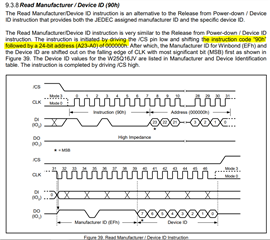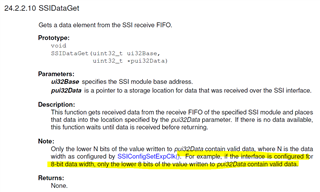Tool/software:
Dear Sir,
We are interfacing W25Q16JLUXIG_TR 16MB flash but not able to read device ID. Also not able to write to flash.
I am attaching the file for reference
// The SSI3 peripheral must be enabled for use.
SysCtlPeripheralEnable(SYSCTL_PERIPH_SSI3);
//
ROM_GPIOPinConfigure(GPIO_PF0_SSI3XDAT1);
ROM_GPIOPinConfigure(GPIO_PF4_SSI3XDAT2);
ROM_GPIOPinConfigure(GPIO_PF5_SSI3XDAT3);
ROM_GPIOPinConfigure(GPIO_PQ0_SSI3CLK);
ROM_GPIOPinConfigure(GPIO_PQ1_SSI3FSS); // Added.
ROM_GPIOPinConfigure(GPIO_PQ2_SSI3XDAT0);
// ROM_GPIOPinTypeSSI(GPIO_PORTF_BASE, GPIO_PIN_0 | GPIO_PIN_4 | GPIO_PIN_5);
ROM_GPIOPinTypeSSI(GPIO_PORTQ_BASE, GPIO_PIN_2 | GPIO_PIN_1 | GPIO_PIN_0); // Added.
ROM_GPIOPinTypeSSI(GPIO_PORTF_BASE, GPIO_PIN_5 | GPIO_PIN_4 | GPIO_PIN_0); // Added..
void Flash_SPI_init(uint32_t ui32SysClock) {
uint32_t pui32Dummy[1];
uint32_t ui32DeviceID;
SSIConfigSetExpClk(SSI3_BASE, ui32SysClock, SSI_FRF_MOTO_MODE_0,
SSI_MODE_MASTER, 1000000, 8);
// Enable the SSI3 module.
ROM_SSIAdvModeSet(SSI3_BASE, SSI_ADV_MODE_WRITE);
SSIAdvFrameHoldEnable(SSI3_BASE);
SSIEnable(SSI3_BASE);
while (SSIDataGetNonBlocking(SSI3_BASE, &pui32Dummy[0])) {
}
Delay(500000);
// First Read the DEVICE ID
ui32DeviceID = SSILibSendReadIDAdvMode(SSI3_BASE);
if (ui32DeviceID != DEVICE_ID) {
Delay(500000);
Delay(500000);
}
// UARTprintf("External Flash Detected with Device ID %x\n",ui32DeviceID);
}
uint32_t SSILibSendReadIDAdvMode(uint32_t ui32Base) {
uint32_t ui32Idx, ui32Receive;
uint32_t ui32MfgID;
uint32_t ui32DevID;
uint32_t ui32ReadID[] = { 0xaa, 0xaa };
uint32_t ui32ReadIDFlash;
for (ui32Idx = 0; ui32Idx < sizeof(g_ui8InstrReadID) / sizeof(g_ui8InstrReadID[0]); ui32Idx++) {
SSIDataPut(ui32Base, g_ui8InstrReadID[ui32Idx]);
}
SSIAdvModeSet(ui32Base, SSI_ADV_MODE_READ_WRITE);
SSIDataPut(ui32Base, 0x00);
SSIDataGet(ui32Base, &ui32Receive);
ui32ReadID[0] = ui32Receive;
SSIAdvDataPutFrameEnd(ui32Base, 0x00);
SSIDataGet(ui32Base, &ui32Receive);
ui32ReadID[1] = ui32Receive;
ui32MfgID = ui32ReadID[0];
ui32DevID = ui32ReadID[1];
ui32ReadIDFlash = ui32MfgID;
ui32ReadIDFlash = ui32ReadIDFlash << 8;
ui32ReadIDFlash |= ui32DevID;
SSIAdvModeSet(SSI3_BASE, SSI_ADV_MODE_WRITE);
return ui32ReadIDFlash;
}
Its 16MB but schemtic it is wrong show 512MB




